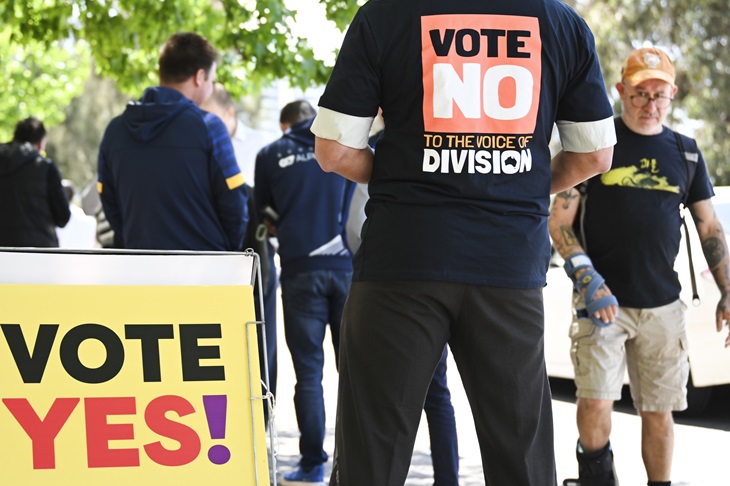Even critics of the defeated Indigenous Voice to Parliament are split on the question of whether the referendum should have gone ahead in the first place. Some think it was a huge waste of money, doomed to failure without bipartisan support, and has left the country more divided than ever. Others believe the referendum was a positive, giving the Australian people a rare chance to directly share their views on the policy priorities of the elites, and the resounding defeat for identity politics represents a great opportunity to reset the agenda in Australia.
But the referendum has also served another useful purpose. It is an endorsement of Australia’s democratic political system.
After their week of mourning for the referendum result, some anonymous Indigenous leaders penned an open letter which included this comment:
‘We do not for one moment accept that this country is not ours. Always was. Always will be. It is the legitimacy of the non-indigenous occupation in this country that requires recognition, not the other way around.’
It would be interesting to know what countries would be ‘legitimate’ in the opinion of the anonymous authors of this letter, and whose ‘recognition’ was required to make them so.
Most countries that exist today were forged by some combination of war, conquest, or revolution. If a country is only legitimate if its origin story is free of bloodshed or wrongdoing, then few would pass muster. But whereas no country can undo whatever sins it is alleged to have committed in the past, a country can seek the ultimate expression of legitimacy: the consent of its people in the here and now.
The framers of the Australian Constitution, in their wisdom, not only set up a system of parliamentary democracy based on the best parts of the British and American models, they also ensured that this system could only be changed if the Australian people consented to it. In some other democracies, the decision to change the constitution is made by politicians. For example, the United States Constitution can be changed if two-thirds of the members of both houses of the US Congress agree, and then it is ratified by the legislatures of three-quarters of the states. Canada has a similar system. The people do not get a direct say in the matter. But in Australia, the decision to change the Constitution is in the hands of voters, not the politicians.
Since Federation, there have been 45 referenda, of which only 8 have been successful. Some bemoan this reality. Constitutional law expert George Williams has written that, ‘Australia’s system of constitutional reform is broken and there is little point in heading back to the polls until this is fixed…’
Contrary to popular perception, Australia’s system for amending its Constitution is easier than most other comparable democracies. Some point to the difficulty in obtaining a ‘double majority’ – an overall majority and a majority in at least four of the six states – but in practice this poses less of an obstacle than the various hurdles in place in the United States and Canada for example. On only five occasions has an overall majority voted ‘Yes’ at a referendum but there was not a sufficient majority of states. With the other 32 unsuccessful referenda, plus the 8 successful ones, 89 per cent of time the overall majority view has prevailed. Someone could only claim such a system is ‘broken’ if they disagree with those majority decisions.
Williams suggests changes that would ‘put Australia on a more successful path of constitutional reform and put decades of failure behind us’. But viewing the outcome of a referendum as a ‘failure’ assumes the goal is to change the Constitution. But a ‘No’ vote is recognisably a vote of confidence in the Australian system, an endorsement of our existing constitutional arrangements.
Australians consistently reject any major change to their Constitution (for example, regarding the proposed republic in 1999) or anything that undermines egalitarianism or the rule of law. In contrast, changes that maintain or enhance egalitarianism, such as the removal of racial distinctions in the 1967 referendum, have been successful. The Voice referendum result was entirely consistent with this approach. Exit polling makes it clear that the leading reason people voted ‘No’ was not because they didn’t understand or didn’t care, but that they felt the proposal was divisive.
To be sure, as a method for seeking the consent of the Australian voters in their system of government, this approach is not perfect. A chance to vote at a referendum only comes around every so often, and only on a specific topic or topics. It is not as though every aspect of Australia’s political system is endorsed by the public every year. But the Australian approach, where we get to participate not only in regular elections to choose our leaders, but periodically get a say on whether we support our overall political system, is far more consensual than arrangements in the vast majority of other countries in the world.
John Storey is the Director of the Legal Rights Program at the Institute of Public Affairs
Got something to add? Join the discussion and comment below.
Get 10 issues for just $10
Subscribe to The Spectator Australia today for the next 10 magazine issues, plus full online access, for just $10.


























Comments
Don't miss out
Join the conversation with other Spectator Australia readers. Subscribe to leave a comment.
SUBSCRIBEAlready a subscriber? Log in